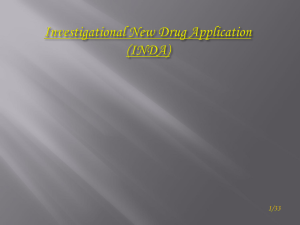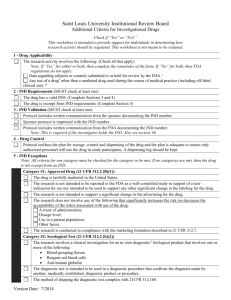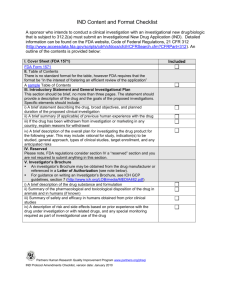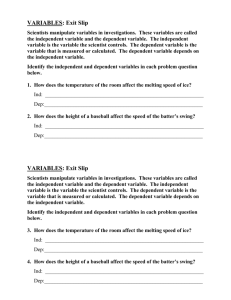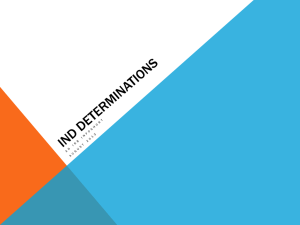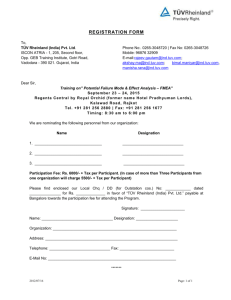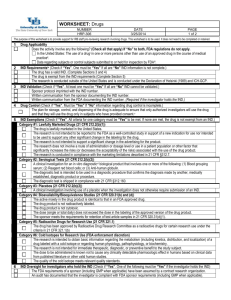Cost recovery, finn
advertisement
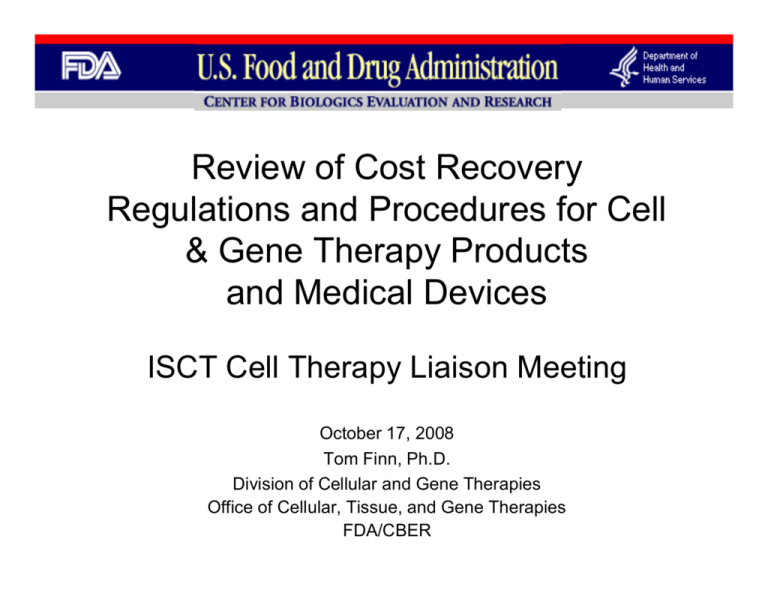
Review of Cost Recovery Regulations and Procedures for Cell & Gene Therapy Products and Medical Devices ISCT Cell Therapy Liaison Meeting October 17, 2008 Tom Finn, Ph.D. Division of Cellular and Gene Therapies Office of Cellular, Tissue, and Gene Therapies FDA/CBER Overview 1. Difference between cost recovery for devices under IDE and cell & gene therapies under IND 2. Cost recovery existing and proposed rules 3. Where cost recovery applies under IND 4. What can be charged for under cost recovery 5. How do you go about requesting cost recovery 6. What information do you have to provide Difference between cost recovery under IDE and IND IDEs: are defined by the device that is used where the regulatory pathway is a PMA or 510(k) to market the device. Under IDE a sponsor only needs to notify the FDA of their intention to charge. INDs: are defined by the product produced where the regulatory pathway is a BLA to market the product. Under IND sponsors must formally request cost recovery and the request must be approved before charging is allowed. The reason for the different approach has to do with historical differences in how these two categories are defined under the statutes and mandated by congress. Cost recovery established and proposed rules Established rule: 21CFR312.7(d) • Under IND sponsors must request cost recovery and the request must be approved prior to charging • Explain why it should not be considered the cost of doing business • Sponsors may not charge more than actual costs Proposed rule: 21CFR312.8 • Submitted to Federal Register on 12/14/06 for public comment • Official comment period closed on 3/20/07, but comments still being submitted • Final rule not yet published • Amends previous rule by providing additional clarification • Does not significantly change previous rule. 21CFR312.7 312.7(d) Charging for and commercialization of investigational drugs- Clinical trials under an IND “In requesting such approval, the sponsor shall provide a full written explanation of why charging is necessary in order for the sponsor to undertake or continue the clinical trial, e.g., why distribution of the drug to test subjects should not be considered part of the normal cost of doing business.” “The sponsor may not commercialize an investigational drug by charging a price larger than that necessary to recover costs of manufacture, research, development, and handling of the investigational drug. 21CFR 312.8 proposed rule Written to provide additional clarification on: 1. Cost recovery of approved drugs under an IND, either as a control or in combination with the investigational drug 2. Expanded access to a therapy under a treatment IND 3. The types of costs that can be recovered • • In general does not expand the types of costs that can be recovered, but does provides clarity on the original rule and how it is often misinterpreted to allow for recovery of things never intended: • Recovering total development costs from inception • Building a new GMP facility that will also be used for the licensed product. Provides more information on how these costs are supposed to be estimated. “Normal cost of doing business” • Cost recovery is not meant to cover the entire cost of running a clinical trial. Essentially, cost recovery is for the purpose of covering the cost of manufacturing, which can be substantial. • It is expected that the sponsor has some financial means to run the trial. • No charges should be made for expenses you would have even if you were not running the trial (e.g. general operating costs, administrative personnel, etc.) “Research and development” costs • Though cost recovery requests across INDs submitted to CBER and CDER are only a small percentage of the total, those sponsors who do submit requests often request recovery for items not intended by the regulations. • Research and development is not meant to apply to early stage and pre-clinical development. It actually applies to developing the therapy for licensure. • Sponsors on occasion have submitted requests for huge sums to cover past expenses or for large planned expenses. How do you go about requesting cost recovery? • According to 312.7(d) FDA must be notified in writing in advance of commencing any such charges • An information amendment should be submitted under 21CFR 312.31. • Cost recovery requests are reviewed by the RPM, the CMC reviewer to evaluate manufacturing costs, and the Medical Officer to evaluate clinical aspects. • For most IND cost recovery requests there is no 30 day review clock. The exception is for treatment (expanded access) INDs which do have a 30 day clock. • You can speed up the review process by providing all the appropriate information in your amendment, including appropriate justification. What information do you have to provide? Although there is no specific template to follow, sponsors need to provide the following information: • Rationale and justification: • Need to demonstrate that without cost recovery you would be unable to provide the therapy. • Provide some evidence that the therapy is promising • Explain why this is not just the cost of doing business • What items you intend to charge: • Major categories of expenses should be listed (e.g. raw materials, equipment, personnel, shipping and storage, etc.) • Do not need to itemized every supply or reagent you use, unless it is particularly expensive. • Cost estimate does not need to be broken down to specific manufacturing steps. The information provided should be concise, but accurate, and provide sufficient detail so the Agency can evaluate if the charges are appropriate and comply with 312.7. Cost recovery for treatment protocol or treatment IND Treatment INDs (expanded access) are conducted for the purpose of providing a promising therapy to benefit very sick patients by permitting them to receive investigational drugs to treat their diseases and conditions, where satisfactory alternative treatment are not available. This is not a traditional IND because this is not part of the normal drug development plan. For treatment INDs cost recovery is also allowable as long as: • • Patient enrollment in any ongoing clinical investigations is not impacted The sponsor of the drug is actively pursuing marketing approval with due diligence. Under the proposed rule cost recovery under expanded access also allows for additional administrative costs as long as they are directly associated with the trial. Direct versus indirect costs Defined differently under IND than how funding agencies define directs/indirects for grant applications Direct costs are those that directly relate to the cost of manufacturing. Indirect costs are not directly associated and include: • Research and development, administrative, labor, or other costs that would be incurred even if the clinical trial or expanded access for which charging is authorized did not occur. • Facilities and equipment that are primarily intended to produce large quantities of drug for eventual commercial sale • Incurred for joint or common objectives Some examples of direct versus indirect costs Direct costs* (allowable) Indirect costs (not allowable) Purchasing and qualification of raw materials Preclinical development of product Equipment used in manufacturing Administrative costs to submit documents to FDA, IRB, DSMB Salaries for personnel who prepare the product Personnel costs to manage patients and trial Shipping and handling product Biomarker development Lot release assays Cost to comply with accreditations * Note that some of these direct costs might need to be prorated to the actual % effort or % use under the IND. Accordingly regulations covering expanded access are also being modified Title Proposed revision §312. 34 - remove Expanded Access to Investigational §312. 35 - remove Drugs for Treatment §312. 36 - remove Use §312. 42 (b)(3) - rev Charging for Investigational Drugs under an IND §312.7 - revise §312.7(d) - remove Proposed rules to be added Subpart I §312.300 §312.305 §312.310 §312.315 §312.320 §312.8 Expanded access Treatment Use of an Investigational New Drug For a Serious OR immediately life-threatening diseases or conditions Existing • • Tx IND/Tx Protocol Emergency IND Proposed • • • Individual patients, including for emergency use 312.310 Intermediate size patient populations 312.315 Tx IND or Tx Protocol 312.320 How much detail needs to be provided? Itemized costs should be based on previous experience or accurate projections. The preparation of these estimates is not expected to be highly burdensome. Cost recovery is approved only for the amount specified. If you have underestimated you will need to submit an amendment that must also be approved. We recommend that you keep detailed records for your own accounting and documentation. Once approved the FDA does not manage or directly oversee these finances, however they are subject to inspection. Cost recovery requests are approved for one year, but can be renewed. Additional thoughts on cost recovery • The regulations do not say who will be charged, only that you are allowed to charge. • • Cost recovery is ultimately calculated per patient (total request divided by number of patients on study). • • In many instances sponsors are expecting to bill insurance companies, but given the experimental nature of the therapy sometimes the patients end up paying. For some therapies the cost per patient may vary. In such cases you need a strategy to figure out how this will be applied. The FDA cannot just approve a variable number. • Specify a minimum and maximum value • Specify criteria as to how per patient costs will be determined • Keep good records Ultimately the sponsor is responsible for making sure that recovered costs were appropriate and documented. Sources of information 21CFR312.7 existing rule (updated annually): http://www.access.gpo.gov/cgi-bin/cfrassemble.cgi?title=200821 or latest electronic version updated regularly at: http://ecfr.gpoaccess.gov/cgi/t/text/textidx?sid=4fb424a18e940eb97b07c575083666d2&c=ecfr&tpl=/ecfrbrows e/Title21/21cfrv5_02.tpl 312.8 proposed rule (docket # 2006N-0061): http://www.regulations.gov/search/index.jsp Preamble to proposed rule: http://www.fda.gov/cber/rules/chargind.htm Summary • Under IND sponsors must request cost recovery and provide justification and a cost breakdown. • Under IDE sponsors need only to notify the FDA of the intention to charge. • Cost recovery is intended to recover costs associated with manufacturing the product, not the cost of doing business. • The proposed rule provides valuable clarification on the existing rule. • Charging for administrative costs is only allowed under expanded access INDs. • Cost recovery is not intended to provide support for highly experimental phase I trials. • Sponsors receiving cost recovery are expected to be actively developing the product for licensure. • “Development” costs do not include expenses of early stage development, but of late stage development for licensure. Who to contact about cost recovery questions As with most questions surrounding your IND you should contact your IND review team. For general questions you can contact: Thomas Finn, Ph.D. Center for Biologics Evaluation and Research/FDA Office of Cellular, Tissue and Gene Therapies Division of Cell and Gene Therapies 1401 Rockville Pike / RM210N / HFM-720 Rockville, MD 20852-1448 Thomas.Finn@fda.hhs.gov Ph. 301-827-5146 Fax. 301-827-9796
